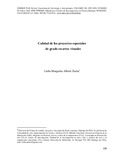Mostrar el registro sencillo del ítem
Calidad de los proyectos especiales de grado en artes visuales
| dc.rights.license | http://creativecommons.org/licenses/by-nc-sa/3.0/ve/ | es_VE |
| dc.contributor.author | Alberti, Liuba | |
| dc.date.accessioned | 2020-12-03T15:28:22Z | |
| dc.date.available | 2020-12-03T15:28:22Z | |
| dc.date.issued | 2020-12 | |
| dc.identifier.issn | 0798-3069 | |
| dc.identifier.uri | http://www.saber.ula.ve/handle/123456789/47165 | |
| dc.description.abstract | Los resultados de la investigación doctoral que se exponen en el siguiente artículo responden a la necesidad de medir y hacer seguimiento al Reglamento para trabajos de grado implementado en la Facultad de Arte de la Universidad de los Andes, Venezuela, en el año 2013. El estudio se centró en el análisis de la calidad estructural de los informes -presentados como Proyectos especiales de grado o Tega-que obtuvieron mención publicación en la Licenciatura de Artes Visuales. La investigación para ello se aplicó el método holopráxico. El instrumento utilizado para el estudio fue la Matriz de análisis integral de Proyectos especiales de grado (MaiPeg). El estudio que se realizó fue de tipo analítico, con diseño documental, transeccional, contemporáneo y univariable. Para el análisis se utilizaron técnicas cuantitativas y se encontró que los trabajos tenían una calidad estructural regular. Se concluyó que la principal debilidad es la falta de coherencia y su mayor fortaleza la exhaustividad. | es_VE |
| dc.language.iso | es | es_VE |
| dc.publisher | SaberULA | es_VE |
| dc.rights | info:eu-repo/semantics/openAccess | es_VE |
| dc.subject | Investigación en arte | es_VE |
| dc.subject | Proyectos especiales | es_VE |
| dc.subject | Investigación creativa | es_VE |
| dc.subject | Calidad en la educación | es_VE |
| dc.subject | Mención publicación | es_VE |
| dc.subject | Tega | es_VE |
| dc.subject | Artes visuales | es_VE |
| dc.subject | Arte y universidad | es_VE |
| dc.subject | Tesis en arte | es_VE |
| dc.title | Calidad de los proyectos especiales de grado en artes visuales | es_VE |
| dc.title.alternative | Quality of special degree projects in visual arts | es_VE |
| dc.type | info:eu-repo/semantics/article | es_VE |
| dc.description.abstract1 | The results of the doctoral research that are exposed in the following article respond to the need to measure and monitor the Regulation for graduate work implemented in the Faculty of Art of the Universidad de los Andes, Venezuela, in 2013. The study focused on the analysis of the structural quality of the reports -presented as Special Degree Projects or Tega- that obtained a publication mention in the Visual Arts Degree. The research was carried out from the vision of the holistic understanding of science, and for this the holopraxic method was applied. The instrument used for the study was the Comprehensive Analysis Matrix for Special Degree Projects (MaiPeg). The study that was carried out was analytical, with a documentary, transectional, contemporary and univariate design. Quantitative techniques were used for the analysis and it was found that the works had a regular structural quality. It was concluded that the main weakness is the lack of coherence and its greatest strength is exhaustiveness. | es_VE |
| dc.description.colacion | 138-166 | es_VE |
| dc.description.email | liuba.alberti@gmail.com | es_VE |
| dc.description.frecuencia | Cuatrimestral | |
| dc.description.paginaweb | www.saber.ula.ve/fermentum | |
| dc.identifier.depositolegal | pp1991102ME302 | |
| dc.publisher.pais | Venezuela | es_VE |
| dc.subject.institucion | Universidad de Los Andes | es_VE |
| dc.subject.keywords | Art research | es_VE |
| dc.subject.keywords | Special projects | es_VE |
| dc.subject.keywords | Creative research | es_VE |
| dc.subject.keywords | Quality in education | es_VE |
| dc.subject.keywords | Publication mention | es_VE |
| dc.subject.keywords | Tega | es_VE |
| dc.subject.keywords | Visual arts | es_VE |
| dc.subject.keywords | Art and university | es_VE |
| dc.subject.keywords | Art thesis | es_VE |
| dc.subject.seccion | Fermentum: Artículos | es_VE |
| dc.subject.tipo | Artículos | es_VE |
| dc.type.media | Texto | es_VE |
Ficheros en el ítem
Este ítem aparece en la(s) siguiente(s) colección(ones)
-
Fermentum - Año 030 - Nº 87
enero-abril 2020


